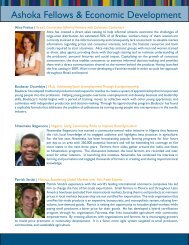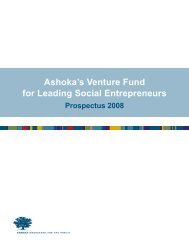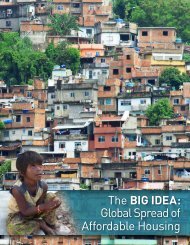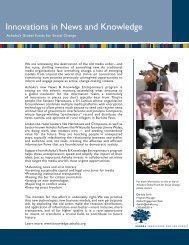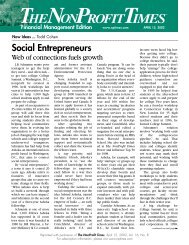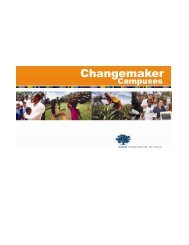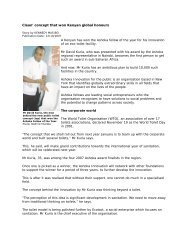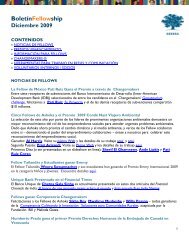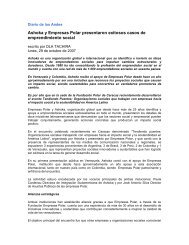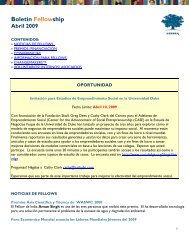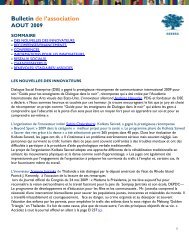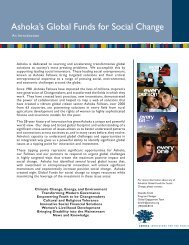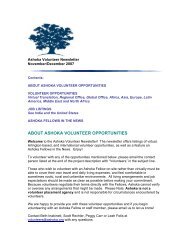Ashoka Measuring Effectiveness Review 3-22-04.indd
Ashoka Measuring Effectiveness Review 3-22-04.indd
Ashoka Measuring Effectiveness Review 3-22-04.indd
Create successful ePaper yourself
Turn your PDF publications into a flip-book with our unique Google optimized e-Paper software.
MEASURING EFFECTIVENESS<br />
A SIX YEAR SUMMARY OF METHODOLOGY AND FINDINGS<br />
A S H O K A I N N O VAT O R S F O R T H E P U B L I C
2<br />
MEASURING EFFECTIVENESS 2004<br />
Executive Summary<br />
<strong>Ashoka</strong> seeks to build an entrepreneurial and competitive citizen sector across the globe. <strong>Ashoka</strong> Fellows,<br />
the world’s leading social innovators, are the backbone for achieving this vision. By supporting these social<br />
entrepreneurs and their new ideas for solving social problems, and by connecting them to one another, <strong>Ashoka</strong><br />
helps spread society’s best innovations and positions a group of leaders to stand at the forefront of citizen sector<br />
development.<br />
In 1997 <strong>Ashoka</strong> designed a system to measure its impact around the world as a tool for both external<br />
communication and internal refl ection. Since then, each year’s “<strong>Measuring</strong> <strong>Effectiveness</strong>” study has focused on<br />
a class of Fellows elected fi ve or ten years prior. This report synthesizes data from the fi rst six years of <strong>Ashoka</strong>’s<br />
<strong>Measuring</strong> <strong>Effectiveness</strong> project.<br />
Part One of this report reviews the importance and diffi culties of measuring the impact of social entrepreneurs.<br />
It examines <strong>Ashoka</strong>’s solution to these challenges — one based on the use of indicators of success — and<br />
includes a discussion on the benefi ts and limitations of this methodology.<br />
Part Two examines <strong>Ashoka</strong>’s continued contact with Fellows over time as well as the response rate for<br />
<strong>Measuring</strong> <strong>Effectiveness</strong>. The former ranges from 97% for fellows fi ve years post election to 70% of Fellows ten<br />
years post election while the latter varies from 83% for Fellows fi ve years post election to 68% for Fellows ten<br />
years post election.<br />
Part Three reviews <strong>Ashoka</strong>’s key indicators of social impact beginning with three measures of the strength of<br />
a Fellow’s new idea: Is the Fellow still working toward his or her original vision (83% ten years post election<br />
and 94% fi ve years post election)? Have others replicated the idea (93% ten years post election and 82% fi ve<br />
years post election)? Has the idea infl uenced public policy (56% fi ve years post election and 71% ten years post<br />
election)? A second indicator gauges the strength of a Fellow’s institution — What position does the Fellow’s<br />
institution hold in the fi eld? (54–66% are seen as leaders in the fi eld).<br />
Part Four examines the value of <strong>Ashoka</strong>’s relationship with each Fellow, fi rst through Fellows’ self-identifi cation<br />
as social entrepreneurs and then by looking at specifi c aspects of this relationship. A series of charts highlight<br />
how, through variables ranging from the Fellow selection process to moral support from staff, <strong>Ashoka</strong> has<br />
enhanced Fellows’ work.<br />
<strong>Ashoka</strong> Fellow Arturo Garcia has created a successful model of campesinoowned<br />
and operated cooperatives that help small farmers obtain real<br />
economic power in Mexico.
<strong>Measuring</strong> Social Change<br />
MEASURING MEASURING EFFECTIVENESS EFFECTIVENESS<br />
2004<br />
<strong>Measuring</strong> <strong>Effectiveness</strong> provides a tool for <strong>Ashoka</strong> to better understand the changes that social entrepreneurs<br />
— with the help of the <strong>Ashoka</strong> Fellowship — are making in their societies. This information is valuable both as<br />
means of communication with <strong>Ashoka</strong>’s partners and as a vehicle for refl ection on institutional practices. But<br />
determining impact is not easy. Social entrepreneurs create complex changes in their societies, often working<br />
from multiple angles and on several levels to solve a problem. The approaches of individual entrepreneurs,<br />
working in an array of fi eld and toward varied aims, make it even more diffi cult to design a standardized tool for<br />
measuring <strong>Ashoka</strong>’s impact.<br />
The case of Mexican Fellow Renata Arantes Villella and her organization Flor Amarela illustrates some of the<br />
challenges in quantifying and evaluating social change for the work of even a single entrepreneur. Renata<br />
joined the <strong>Ashoka</strong> Fellowship in 1995 for her efforts to implement a comprehensive model for the education,<br />
rehabilitation, and social integration of disabled people of all ages. The following information comes from a case<br />
study conducted by an <strong>Ashoka</strong> staff member in 2000:<br />
• Renata directly serves the 200 students attending her school in rural Mexico.<br />
• Renata worked with local hospitals to introduce a test for newborn children that ensures early diagnosis and<br />
thus opens the door for prompt treatment. Hospitals now register disabilities and refer qualifi ed children to<br />
Renata’s school.<br />
• Renata convinced her local municipality and state governments to invest in special education programs.<br />
• An estimated 600 people have participated in workshops on pre-natal care, nutrition, and alcoholism – key<br />
causes for disability.<br />
• Renata broadcasts a monthly radio program reaching 5,000 people.<br />
Valuing Numbers<br />
The simplest approach to impact assessment begins with the most basic of questions: how many? But even a<br />
quick analysis of Renata’s work highlights the limitations of any purely quantitative approach. Numbers alone<br />
fall short of describing the diverse set of changes set forth by Renata’s work. Consider the following:<br />
• The 200 students enrolled in the Flor Amarela School will live profoundly improved lives, each individual<br />
functioning more independently and as part of a family and community that recognizes his or her humanity<br />
and potential. These students come from a total of 150 families, each with multiple members that will directly<br />
experience this change in their newly independent son, sister, or cousin.<br />
• Hospital-based programs both broaden and deepen Renata’s impact. Early diagnosis improves outcomes for<br />
all children diagnosed through the procedure, but even more so for those then referred to Renata’s school.<br />
The hospital registry, through its mere existence, profoundly alters the traditional Mexican paradigm around<br />
disability. Before Renata’s registry, many disabled people remained hidden in their homes while others were<br />
ignored by society and left to beg or wander the streets. This treatment becomes untenable when a respected<br />
3
4<br />
MEASURING EFFECTIVENESS 2004<br />
public institution — such as the hospital — and a group of revered professionals — the local doctors — offi cially<br />
acknowledge and record disability. Moreover, each hospital’s success encourages other hospitals to follow<br />
down the same path, thereby promoting expansion of these interventions.<br />
• Policy changes, and especially the number of people they ultimately reach, can be particularly diffi cult to<br />
quantify. The funds available from Renata’s municipality, along with money trickling down from the state level,<br />
clearly enable her local success. State funding also reaches untold numbers outside this local context.<br />
• Renata’s work on prevention constitutes a separate level of impact. Downstream indicators, such as rates of<br />
birth defects or demand for prenatal care, could provide some indication of the project’s reach. With a widely<br />
dispersed audience, the infl uence of Renata’s work becomes diffi cult to identify. For those whom it reaches,<br />
program effects may vary widely – some mothers will entirely avert birth defects, while others will marginally<br />
improve their infant’s health.<br />
Numbers alone represent just one dimension of a rich set of changes in the way society functions. But in the<br />
context of broader stories, they provide a sense of scale and enhance understanding of a Fellow’s work. While<br />
these stories and their embedded numbers are helpful for analyzing independent cases, they can not be<br />
aggregated across social entrepreneurs.<br />
Systemic Change<br />
Each of Renata’s successes independently represents a critical step toward integrating disabled individuals<br />
into society as productive and respected members. Together, however, they create a new system for dealing<br />
with disabilities on the community level. Renata does not single-handedly seek out individuals with disabilities<br />
and draw them into her program. Instead, through her work in local hospitals, she has created a systematized<br />
process that allows the medical community to perform that function for society. Nor does she independently<br />
raise the money needed to maintain her program; instead she has changed policy on the state and local levels<br />
to free necessary funds. To complement this, Renata has created local institutions to carry out her mission.<br />
The school she initiated functions independently to teach children with special needs and Flor Amarela, the<br />
organization that Renata currently leads, serves as a central point for implementing her vision.<br />
Renata has built a new system that empowers both disabled individuals and their communities (doctors,<br />
families, etc...) to change the way disabilities are treated. Over time, this system creates a more enabling<br />
environment by changing the community mind set toward disability. Renata reports clear signs that attitudes<br />
have changed within the larger community — people with disabilities are now widely viewed as productive<br />
members of society. As stereotypes dissolve, individuals with disabilities face a friendlier environment with more<br />
opportunities and less dismissal.<br />
Spread and Trajectory<br />
According to her 2000 interview, Renata began by locally demonstrating her work to create a replicable model.<br />
However, at the time of the interview, she had not yet spread that model beyond the area served by her school.<br />
This raises the third critical diffi culty in measuring social impact. <strong>Ashoka</strong> specifi cally selects for individuals with<br />
broad visions for changing nation-wide systems. This change takes time. As with many social entrepreneurs, we<br />
can not judge Renata’s overall trajectory by the achievements of her fi rst fi ve years alone.
Methodology:<br />
<strong>Ashoka</strong>’s Solution to <strong>Measuring</strong> Impact<br />
MEASURING MEASURING EFFECTIVENESS EFFECTIVENESS<br />
2004<br />
<strong>Ashoka</strong> designed its <strong>Measuring</strong> <strong>Effectiveness</strong> study to specifi cally address the diffi culties of assessing impact.<br />
Each Fellow in that class receives a multiple-choice, self-response questionnaire and a cross section participate<br />
in in-depth interviews.<br />
Design<br />
Proxy Indicators: The multiple-choice questionnaire relies on a series of “proxy indicators” that serve as<br />
measures of <strong>Ashoka</strong>’s successes toward strengthening civil society by supporting social entrepreneurs, their<br />
ideas, and institutions.<br />
Does the idea persist and has it spread?<br />
• Are you still working toward your original vision?<br />
• Have others replicated your original idea?<br />
• Have you had impact on public policy?<br />
Has an institution been created or expanded?<br />
• What position does the institution currently hold in the fi eld?<br />
Has the Fellow’s relationship with <strong>Ashoka</strong> “enhanced” his or her work?<br />
• Do you identify yourself as a social entrepreneur?<br />
• Have specifi c aspects of your relationship with <strong>Ashoka</strong> enhanced your work?<br />
Timing: The <strong>Measuring</strong> <strong>Effectiveness</strong> study captures a snapshot in time. <strong>Ashoka</strong> expects Fellows’ trajectories to<br />
change as they develop new strategies and improve their ability to spread their ideas.<br />
Qualitative information: In-depth interviews supplement the surveys and provide a basis for understanding<br />
Fellows’ work. These case studies carried out by <strong>Ashoka</strong> staff introduce some of the richness lost by quantitative<br />
and multiple-choice responses alone. The reader learns, for example, which groups of citizens have been<br />
impacted, the systemic nature of the change, and the proposed strategies for long-term spread.<br />
<strong>Ashoka</strong> Fellow Elna Kotze is reversing South Africa’s unjust and<br />
environmentally destructive land-use practices by creating local “land-use<br />
fora” organized around water catchment areas.<br />
5
6<br />
MEASURING EFFECTIVENESS 2004<br />
Limitations<br />
The methods used for <strong>Ashoka</strong>’s <strong>Measuring</strong> <strong>Effectiveness</strong> project introduce some limitations.<br />
Self Reporting: All of the information presented here is reported directly by Fellows themselves. Fellows are<br />
encouraged to respond honestly and are explicitly told that the <strong>Measuring</strong> <strong>Effectiveness</strong> study does not evaluate<br />
their success but rather <strong>Ashoka</strong>’s impact on the fi eld.<br />
Internal Process: <strong>Ashoka</strong> staff around the world execute all steps of the <strong>Measuring</strong> <strong>Effectiveness</strong> project from<br />
design to analysis. <strong>Ashoka</strong> has maintained this internal process both because it reduces resource intensity<br />
relative to external evaluation and because it allows the study to account for <strong>Ashoka</strong>’s particular perspective on<br />
social change.<br />
Irregularities: This report includes work done over six years in more than 20 countries. The questionnaire<br />
was refi ned slightly through the years but without fundamental change. Translation naturally introduces some<br />
distortions. While most Fellows were contacted and responded via e-mail, a portion responded to survey<br />
questions over the phone or in person.<br />
Working in the favelas of Rio de Janeiro, <strong>Ashoka</strong> Fellow Vera Cordeiro and her<br />
organization, Saúde Criança Renascer, provide emergency assistance to ill children<br />
from low income families during and immediately after hospitalization.
MEASURING MEASURING EFFECTIVENESS EFFECTIVENESS<br />
2004<br />
The Fellowship<br />
Once elected, leading social entrepreneurs join the <strong>Ashoka</strong> Fellowship for life. Most Fellows stay connected to<br />
<strong>Ashoka</strong> but, over the course of years, the Fellowship loses a few of its members.<br />
5 Years Post Election<br />
���<br />
����������<br />
���������������<br />
What the Numbers Mean<br />
Fellows in Active Contact with Fellowship<br />
����������������������<br />
���<br />
�����������<br />
���������������<br />
A small set of circumstances account for most cases of Fellows losing contact with the Fellowship. In some<br />
instances death, ethical concerns, Fellow request, or career change are responsible. Most often however,<br />
Fellows have simply lost touch with <strong>Ashoka</strong> as they moved beyond their original venture.<br />
The evolution of <strong>Ashoka</strong>’s Fellowship program suggests a major reason for the disparity between Fellows elected<br />
fi ve and ten years ago. Since 1981 <strong>Ashoka</strong> has increasingly institutionalized Fellow engagement. The inception<br />
of funding for collaboration, along with a greater emphasis on creating a global community of leading social<br />
entrepreneurs, likely spurred greater Fellow involvement and better communication in all of the post-stipend<br />
years.<br />
7
8<br />
MEASURING EFFECTIVENESS 2004<br />
Response Rates<br />
Each year, the majority of Fellows from the survey class respond to the <strong>Measuring</strong> <strong>Effectiveness</strong> survey.<br />
The numbers below indicate the percentage of Fellows contacted by their local representative who<br />
subsequently responded to the survey.<br />
���������������������<br />
���<br />
��������<br />
What the Numbers Mean<br />
����������������������<br />
���<br />
��������<br />
Fellows elected more recently tend to participate in Fellowship activities and have a closer relationship with their<br />
local country offi ces. As mentioned earlier, <strong>Ashoka</strong> has increased staff contact with Fellows and opportunities<br />
for collaboration within the Fellowship, initially through the global Fellowship Support Services and later through<br />
local Fellowship programs. In the mid- to late-1990s <strong>Ashoka</strong> introduced a series of programs that further<br />
engaged Fellows including the Environmental Innovations Initiative and the Innovative Learning Initiative. Most<br />
recently, Fellow exchanges and collaborations, designed to spark an active association of social entrepreneurs,<br />
have become core to <strong>Ashoka</strong>’s mission. <strong>Ashoka</strong> expects Fellow response rates to continue to rise as a result.<br />
<strong>Ashoka</strong> Fellow Laxman Singh is building water conservation and natural resource<br />
management systems for rural communities in drought-prone districts of Rajasthan state in<br />
western India.
MEASURING MEASURING EFFECTIVENESS EFFECTIVENESS<br />
2004<br />
The Idea: The Original Vision<br />
<strong>Ashoka</strong> seeks out social entrepreneurs with a lifelong commitment to their vision for the future. This<br />
continued dedication signals a Fellow’s ongoing effort to spread a new idea or practice in society.<br />
Are you still working toward your original vision?<br />
�������������<br />
���<br />
��<br />
��<br />
��<br />
��<br />
What the Numbers Mean<br />
�<br />
��������������������������������������<br />
���<br />
��������<br />
�������������<br />
���<br />
���������<br />
�������������<br />
How might Fellows fi ve or ten years post election continue working toward their vision? These<br />
stories illustrate some common variations:<br />
Fellows establish sustainable institutions and continue in an advisory role<br />
Anna Johanson entered the Fellowship with a plan to change the treatment of disabled children in Mexico<br />
through a system including comprehensive therapy at the Piña Palmera center and participatory outreach to<br />
families and communities. Her spread strategy prioritizes these basic principles rather than the specifi c model<br />
for their implementation, and occurs through workshops, visits to the Piña Palmera site, and participation<br />
in larger forums on disability issues. Anna began planning for the end of her leadership as soon as she was<br />
elected to the <strong>Ashoka</strong> Fellowship, increasingly handing over decision making power to other leaders and<br />
democratizing the institutional structure. In 2003, she passed on her last responsibility in the institution and<br />
moved to Oaxaca City where she remains on the organization’s board as a consultant.<br />
9
10<br />
MEASURING EFFECTIVENESS 2004<br />
Fellows change strategy but continue toward vision<br />
When Didit Adidananta began working with street children in Indonesia, his work had an internal focus - helping<br />
the street children conceive of an alternative way of life and dealing with their individual problems. Today, he<br />
looks to change the environment in which these children live by involving all members of society in solving<br />
their problems. Local forums connect youth to their communities, education efforts build awareness about the<br />
problems faced by street children, shelters provide a safe space for these youth, and the federal Child Protection<br />
Agency is now responsive to their needs. Didit continues working toward a better world for street children but<br />
through dramatically different strategies than he initially conceived.<br />
Fellows form domestic institutions and move to coalition-building for the fi eld<br />
When elected to the <strong>Ashoka</strong> Fellowship, Halidou Ouédraogo was setting up a national organization empowering<br />
the citizens of Burkina Faso to work toward protecting their own human rights. This institution continues to<br />
thrive, but Halidou has shifted his focus to helping outside pressure groups infl uence governments. Rather than<br />
relying on traditionally western-based groups to fi ll this role, Halidou has built a pan-African coalition of over 40<br />
Human Rights organizations.<br />
Fellows continue in a consulting role after private sector adopts the new idea<br />
<strong>Ashoka</strong> Fellow Suraiya Haque founded the organization Phulki to prove to Bangladeshi factories that opening<br />
childcare facilities would be profi table in the long run. To achieve this goal, Suraiya built and implemented a<br />
sustainable model for factory child care centers, harnessing resources from garment manufacturers, mothers,<br />
garment buyers, donors, and government, and using those resources to demonstrate the net profi tability of infactory<br />
child care. Rather than acting as a child care provider itself, Phulki aimed to have factories themselves<br />
take on this role as a part of their business strategy. As demand for her model increased, Suraiya became a<br />
consultant to factory owners who wished to implement her program.<br />
Carlos Vargas García, a doctor, is developing and implementing new strategies to provide safe,<br />
affordable, and healthy childbirth services to poor families in Mexico.
MEASURING MEASURING EFFECTIVENESS EFFECTIVENESS<br />
2004<br />
Changes Over Time<br />
As shown above, Fellows fi ve years post election (94%) are signifi cantly more likely than their ten year<br />
counterparts (83%) to report continued work toward their original vision. This may be due in part to the simple<br />
passing of time -— all else equal, Fellows are more likely to leave the work for which they were elected as more<br />
time passes. A look at the data suggests that this is not the only reason.<br />
�������������<br />
���<br />
��<br />
��<br />
��<br />
��<br />
�<br />
���������������������������������������<br />
����������������������<br />
���<br />
���<br />
���<br />
���� ����<br />
������������<br />
����<br />
Fellows elected more recently are<br />
increasingly likely to continue working<br />
toward their original vision 10 years after<br />
their election.<br />
FELLOWSHIP CHANGES OVER TIME<br />
Two independent factors account for differences between Fellows interviewed fi ve and ten years post election:<br />
1) Fellows move further beyond the launch stage of their work, 2) Fellows were elected at different points in<br />
<strong>Ashoka</strong>’s evolution.<br />
Several facts suggest that the latter explanation plays at least some role in this disparity. First, as shown<br />
above, Fellows are increasingly working toward their original vision ten years after their election. Second, as<br />
illustrated on page 12, Fellows fi ve years post election report independent replication more than those ten<br />
years post election. This trend cannot be the product of Fellows moving beyond the early stages of their work.<br />
Possible explanations corresponding to the evolution of <strong>Ashoka</strong> and its environment over time include:<br />
Change within <strong>Ashoka</strong><br />
• <strong>Ashoka</strong> has improved the application of its criteria for election to the Fellowship.<br />
• As the Fellowship grows, <strong>Ashoka</strong>’s network of social entrepreneurs becomes an increasingly powerful<br />
resource.<br />
External Changes<br />
• Stronger civil societies around the world have created a more enabling environment for social<br />
entrepreneurship.<br />
• Increasing bridges to other sectors and better communication within the sector make replication and the<br />
spread of ideas more feasible.<br />
• More resources are available for the citizen sector worldwide.<br />
11
12<br />
MEASURING EFFECTIVENESS 2004<br />
The Idea: Replication<br />
Replication is not the only sign that an idea has spread. But it is one indication that an idea has<br />
taken root. Fellows who succeeded on this front have moved beyond their direct impact to infl uence<br />
the way other groups in society approach an issue.<br />
Has your work been replicated by an individual or group that you did<br />
not lead?<br />
�������������<br />
���<br />
What the Numbers Mean<br />
��<br />
��<br />
��<br />
��<br />
�<br />
��������������������������������������<br />
���<br />
��������<br />
�������������<br />
���������<br />
�������������<br />
How does replication happen independently of a Fellow’s leadership? Here are a few examples:<br />
Vera’s organization (ACSR) has replicated its model in 14 other public hospitals (11 in the Rio de Janeiro<br />
area and remaining 3 in other Brazilian states). ASCR supports this network of “sister” organizations through<br />
capacity-building workshops, information exchange, and contacts. Sometimes ASCR helps with fundraising<br />
but each “sister” is independent. Approximately 20,000 people have been reached directly through the<br />
network of ASCR and its sister organizations.<br />
--Vera Cordiero, Brazil 2003, 10 years post election<br />
Celia’s organization AVERMES has attracted considerable media attention for successfully helping its clients<br />
obtain legal redress for losses suffered as a result of medical malpractice or inadequate services in stateoperated<br />
clinics and hospitals. The growing public awareness of AVERMES work has spawned at least fi ve<br />
organizations in other parts of Brazil that are pursuing similar aims.<br />
--Celia Marina Destri Dos Santos, Brazil 1998, 5 years post election<br />
Petra’s organization spreads its work through informal collaboration with other institutions. It does not create<br />
these organizations, but they learn and are inspired by her work.<br />
���<br />
--Petra Vitousova, Czech Republic 2000, 5 years post election
MEASURING EFFECTIVENESS EFFECTIVENESS<br />
2004<br />
The Idea: Policy Change<br />
Changes in government policy signal the adoption of a Fellow’s idea in the public sphere. Through<br />
policy change, existing systems in society can be broadly reformed.<br />
Have you contributed to policy change on the national level?<br />
�������������<br />
What the Numbers Mean<br />
���<br />
��<br />
��<br />
��<br />
��<br />
�<br />
����������������������������<br />
���<br />
��������<br />
�������������<br />
���<br />
���������<br />
�������������<br />
How do Fellows infl uence national policy? The following illustrate a number of ways:<br />
In 1984, Halidou contributed to changes in Burkina’s sentencing laws, moving from a system with mandatory<br />
minimum sentences to one which allows for fl exibility. Then, in 1990, Halidou drafted Burkina Faso’s new<br />
constitution, which was later ratifi ed and adopted by the government. Years later, in 1997, Halidou was<br />
involved in the codifi cation of laws regarding violence against women.<br />
--Halidou Ouedraogo, Burkina Faso 2000, 5 years post election<br />
The Indonesian government has created the LPA (Child Protection Agency) along with Didit’s help and<br />
consultation. This institution will focus on ways to protect children and will have branch offi ces in each<br />
province. Didit notes that street children cannot gain access to government services because they do not<br />
have offi cial ID cards. He believes that this has to be addressed through policy change. Didit hopes that his<br />
advocacy work to raise awareness in the general public will put pressure on the government to pass laws that<br />
are supportive of childrens’ rights.<br />
--Didit Adidananta, Indonesia 1998, 10 years post election<br />
Michal launched his “Water for the 3rd Millennium” program in 1993 and a Slovak government adopted it as<br />
part of the state’s offi cial water management policy in 1994. The program incorporates community voice into<br />
decision making on water issues.<br />
--Michal Kravcík, Slovakia 1998, 5 years post election<br />
13
14<br />
MEASURING EFFECTIVENESS 2004<br />
Institution: Institutional Status<br />
The prevalence of strong institutions serves as a gauge of growth in the citizen sector. As Fellows develop<br />
stable institutions that lead their fi elds, they not only spread their own ideas, but also reinforce broader<br />
social-sector activity.<br />
How has your institution evolved since you were elected to the <strong>Ashoka</strong><br />
Fellowship?<br />
1) The institution is recognized as a leader in its fi eld<br />
2) The Institution has grown and stabilized<br />
3) The institution still exists but faces major challenges<br />
4) The institution has ceased to exist<br />
�������������<br />
���<br />
What the Numbers Mean<br />
��<br />
��<br />
��<br />
��<br />
�<br />
���������������������������������������<br />
���<br />
��������<br />
�������������<br />
��������<br />
�������������<br />
Institution Recognized as a Leader in it’s Field<br />
Fellow Ismael Ferreira’s institution APAEB covers 15 towns with a total population of approximately 450,000<br />
inhabitants, 65 percent of whom still live in the countryside (in accord with the institutions goals). With revenues<br />
of US $7 million and 980 workers directly employed, APAEB is not only the second-largest employer in Valente,<br />
but it has also transformed the economy of the region where an estimated 500,000 people depend on sisal.<br />
750 farmer families are members of APAEB and about 2,000 sell sisal fi bers to the association. Overall, APAEB<br />
has contributed to reducing migrations to urban centers and has greatly improved farmers’ incomes and<br />
livelihoods in the region. It has become a leading model for all rural development organizations in Brazil.<br />
Institution has Ceased to Exist<br />
Fellow Beaulah Thumbadoo’s strategies to promote literacy in South Africa through her organization ERA<br />
(Everyone’s Reading in Africa) were adopted by the national government after a period of tireless lobbying.<br />
In the ensuing years, Beaulah disolved ERA and has worked as an advisor to the government to improve its<br />
implementation of her ideas.<br />
���
MEASURING MEASURING EFFECTIVENESS EFFECTIVENESS<br />
2004<br />
Relationship with <strong>Ashoka</strong>: Self Identity as a Social Entrepreneur<br />
<strong>Ashoka</strong> works to build social entrepreneurship as a viable profession in order to catalyze the growth of a<br />
competitive and entrepreneurial citizen sector. <strong>Ashoka</strong> Fellows publicly set the standard for entrepreneurial<br />
practice in the social sector and challenge others to act and address the social problems around them.<br />
In what situations do you identify yourself as a social entrepreneur?<br />
1) With the press<br />
2) Socially<br />
3) Professionally<br />
4) Other<br />
5) Do not identify as a social entrepreneur<br />
What the Numbers Mean<br />
���������������������������������������������<br />
���<br />
���<br />
Vera reports that before she was elected, she did not know what she was. She was a doctor that didn’t practice<br />
medicine in the traditional way. She didn’t know that there was a profession called social entrepreneurship:<br />
“<strong>Ashoka</strong> gave me an identity. I used to love to say that I was an <strong>Ashoka</strong> Fellow in all environments - even when<br />
no one knew what it meant. I’d explain it to them and then more people would know.”<br />
--Vera Cordiero, Brazil 2004, 10 years post election<br />
“Having identifi ed myself as a social entrepreneur was truly signifi cant. It defi ned my role and gave me the<br />
security of belonging to a network of people with similar abilities and vocations.”<br />
--Ximena Abogabir, Chile 1998, 5 years post election<br />
15
16<br />
MEASURING EFFECTIVENESS 2004<br />
Relationship with <strong>Ashoka</strong>: <strong>Ashoka</strong>’s Added Value<br />
By helping Fellows succeed, <strong>Ashoka</strong> spreads society’s best new innovations and positions a group of<br />
leaders to stand at the forefront of citizen sector development<br />
How has your relationship with <strong>Ashoka</strong> contributed to the success<br />
of your work?<br />
1) Has made a critical difference<br />
2) Has made a signifi cant difference<br />
3) Has made some difference<br />
4) Has made no difference<br />
Fellows fi ve years post election valued particular aspects of <strong>Ashoka</strong> more than Fellows ten years post election.<br />
However, those who had been in the Fellowship longer saw <strong>Ashoka</strong> overall as more important than did their more<br />
recently elected counterparts. The charts on pages 16 to 19 indicate the percentage of Fellows responding that<br />
each aspect of their relationship with <strong>Ashoka</strong> had a critical or signifi cant impact on their work (1 or 2 out of 4).<br />
�����������������������<br />
����������������������������������<br />
���<br />
<strong>Ashoka</strong>’s Impact: Fellow Stipend<br />
��<br />
��<br />
��<br />
��<br />
�<br />
�������������������������������<br />
���<br />
�������<br />
�������������<br />
���<br />
��������<br />
�������������<br />
Critical Difference<br />
Being a Fellow was important because Diva had three years to work full time on her idea. She was able to build<br />
legitimacy as a leader in the Black movement. Before this, her constituents saw her as more of a technician<br />
than as a strong force for change. Now she has a structured institution and is doing rather than simply talking.<br />
In many ways, this exposure allowed her to build an impressive institution and create the impact she has<br />
achieved to date.<br />
--Diva Moreira, Brazil 1999, 10 years post election
�����������������������<br />
����������������������������������<br />
���<br />
��<br />
��<br />
��<br />
��<br />
�<br />
����������������������������������<br />
���<br />
�������<br />
�������������<br />
���<br />
��������<br />
�������������<br />
<strong>Ashoka</strong>’s Impact: Moral Support<br />
Critical Difference<br />
“<strong>Ashoka</strong> was the fi rst organization to express confi dence in<br />
my plans, which gave me the courage to continue working<br />
on my project.”<br />
--Anuradha Kapoor, India 2000<br />
5 years post election<br />
Some Difference<br />
Celia notes that her election as an <strong>Ashoka</strong> Fellow was a<br />
signifi cant “affi rmation of the importance of her work”<br />
and a source of “the courage needed to overcome diffi cult<br />
obstacles.”<br />
--Celia Destri, Brazil 1998<br />
5 years post election<br />
MEASURING MEASURING EFFECTIVENESS EFFECTIVENESS<br />
2004<br />
<strong>Ashoka</strong>’s Impact: The Selection Process<br />
Critical Difference<br />
“The best part was contact with <strong>Ashoka</strong> staff member<br />
Ryszard before I was elected. We corresponded over mail<br />
for 1 to 2 years. He asked good questions about my project<br />
that made me think about things. For example, Ryszard<br />
wanted to know why I did not start an organization. I thought<br />
that I didn’t need one, but then, three years ago, I realized<br />
we needed to be an independent body and I started my<br />
organization. He also asked me details about the project,<br />
what I want to have done in ten years. The process of<br />
sitting down and writing, going through good arguments<br />
was important and much more diffi cult than just talking in<br />
circles.”<br />
-Jack Shindler, Poland 2000<br />
5 years post election<br />
Signifi cant Difference<br />
“That panel was practically a doctoral exam. I confronted<br />
many questions that I had never before considered.”<br />
-Judith Santos, Mexico 2000<br />
5 years post election<br />
�����������������������<br />
����������������������������������<br />
���<br />
��<br />
��<br />
��<br />
��<br />
�<br />
������������������������������<br />
���<br />
�������<br />
�������������<br />
���<br />
��������<br />
�������������<br />
17
18<br />
MEASURING EFFECTIVENESS 2004<br />
<strong>Ashoka</strong>’s Impact: Communication<br />
Signifi cant Difference<br />
Cida Bento specifi cally talks about the “accompaniment”<br />
or follow-through that Brazil directors Cindy Lessa and<br />
Monica de Roure provided to her following her election.<br />
Monica’s support was particularly important in terms of<br />
helping Cida on strategic planning for the growth of her<br />
organization.<br />
--Maria Aparecida Bento, Brazil 2000<br />
5 years post election<br />
Some Difference<br />
“Comments on quarterly reports from Bill Drayton and<br />
other head offi ce staff were useful for strategizing and<br />
fi eld level testing.”<br />
--Mohammad Zakaria, Bangladesh 1999<br />
10 years post election<br />
<strong>Ashoka</strong>’s Impact: Fellow Collaboration<br />
Critical Difference<br />
Joel feels that his exchange of ideas with other Fellows<br />
working on housing issues across Asia have been<br />
absolutely critical to his success in transforming South<br />
Africa’s own housing situation.<br />
--Joel Bolnick, South Africa 1998<br />
5 years post election<br />
No Difference<br />
Cheik reports that there was no follow-up from attending<br />
Fellows after the Resine Challenge Pot workshop in Dakar<br />
that included eight environmental Fellows from West Africa.<br />
--Cheik Amala Taboure, Mali 2000<br />
5 years post election<br />
�����������������������<br />
����������������������������������<br />
�����������������������<br />
����������������������������������<br />
��<br />
��<br />
��<br />
��<br />
��<br />
��<br />
�<br />
��<br />
��<br />
��<br />
��<br />
��<br />
�<br />
������������������������������<br />
���<br />
�������<br />
�������������<br />
���<br />
�������<br />
�������������<br />
���<br />
��������<br />
�������������<br />
�������������������������������������<br />
���<br />
��������<br />
�������������<br />
<strong>Ashoka</strong> Fellow Ercan Tutal of Turkey offers citizens of all ages with disabilities the<br />
opportunity to confront and overcome challenges through sports.
�����������������������<br />
����������������������������������<br />
��<br />
��<br />
��<br />
��<br />
��<br />
�<br />
�����������������������������<br />
���<br />
�������<br />
�������������<br />
���<br />
��������<br />
�������������<br />
MEASURING MEASURING EFFECTIVENESS EFFECTIVENESS<br />
2004<br />
<strong>Ashoka</strong>’s Impact: Opening Doors<br />
Critical Difference<br />
Although <strong>Ashoka</strong> opened doors in some but not all social<br />
sector circles in Mexico, Pati sees power not in the <strong>Ashoka</strong><br />
brand but in the specifi c, personal connections available<br />
through high-level channels. Pati believes that the GEF<br />
funding — now the cornerstone of her impact — came about<br />
in large part due to her association with <strong>Ashoka</strong>. After her<br />
election, Bill Drayton served as a reference for Pati in the<br />
GEF selection process. In this sense, the most important<br />
development for her organization would not have happened<br />
if Pati had not been an <strong>Ashoka</strong> Fellow.<br />
-----Pati Ruiz Corso, Mexico 2000, 5 years post election<br />
Signifi cant Difference<br />
Larry Silberman reports that <strong>Ashoka</strong> has a brand recognition that suggests quality and trustworthiness. <strong>Ashoka</strong><br />
doesn’t yet mean much for many funding sources, but it did with the Ford Foundation and most recently people<br />
associated with the Rockefeller Group. And he is sure that as he goes fundraising for his expansion plans, he<br />
will brandish the <strong>Ashoka</strong> connection and with international foundations, at least, it will help him.<br />
�����������������������<br />
����������������������������������<br />
���<br />
��<br />
��<br />
��<br />
��<br />
�<br />
������������������������������<br />
���<br />
�������<br />
�������������<br />
���<br />
��������<br />
�������������<br />
--Larry Silberman, Mexico 2000, 5 years post election<br />
<strong>Ashoka</strong>’s Impact: Overall Support<br />
Critical Difference<br />
“The international support was very important to me<br />
psychologically… The fact that someone in another country<br />
who did not know me had the confi dence to fund me for<br />
three years is really incredible. I think it is such an amazing<br />
idea. It was my defi ning moment professionally. But it was<br />
ironic going from a stranger funding me in full confi dence<br />
to local funding that came with so many questions. I don’t<br />
know what would have happened if <strong>Ashoka</strong> never came<br />
along.”<br />
-Petra Vitousova, Czech Republic 2000<br />
5 years post election<br />
“The valuing of my work, motivation, and commitment has<br />
never been as well recognized as with <strong>Ashoka</strong>, benefi ting my<br />
self esteem and renewing the commitment I had made for<br />
my life.”<br />
--Dante Pesce, Chile 1998, 5 years post election<br />
19
20<br />
MEASURING EFFECTIVENESS 2004<br />
Conclusions:<br />
<strong>Ashoka</strong> envisions a world where all people are changemakers – individuals who feel empowered to create<br />
change when they see a need in society. Toward this end, it acts to promote an active, entrepreneurial civil<br />
society across the globe. <strong>Ashoka</strong> Fellows, the world’s leading social entrepreneurs, create systemic changes<br />
in their societies. Through their leadership, both as individuals and through their ideas and institutions, they<br />
create the spaces and conditions that empower individuals to become changemakers. This type of leadership,<br />
and the systemic change it accompanies, can be diffi cult to measure and even describe. But the data in this<br />
report suggests that <strong>Ashoka</strong> Fellows, with <strong>Ashoka</strong>’s support, are increasingly fomenting fundamental changes<br />
in their societies. The following points summarize the basis for this conclusion:<br />
• <strong>Ashoka</strong> has made concrete efforts to reengage older Fellows and to formalize Fellowship activities. As a<br />
result, more recently elected Fellows tend to have higher levels of engagement in the Fellowship and have<br />
been more likely to respond to the <strong>Measuring</strong> <strong>Effectiveness</strong> survey.<br />
• Fellows that remain in contact with <strong>Ashoka</strong> continue working toward their original vision in very high<br />
numbers. The growing network of dedicated and experienced Leading Social Entrepreneurs serves as a<br />
broadening base for both systemic social change and for collaboration toward that change.<br />
• As Fellows advance beyond their stipend period, their institutions are more likely to lead their fi elds and<br />
their work is more likely to infl uence public policy. Again, this implies a growing richness as more Fellows<br />
move beyond their initial stipend period.<br />
• Fellows elected more recently have their work replicated by other institutions in higher numbers than<br />
their counterparts elected earlier in <strong>Ashoka</strong>’s history. They also continue working toward their original vision<br />
for change well beyond their election to the Fellowship in greater numbers. The root of this change remains<br />
unclear. It may include improvements in <strong>Ashoka</strong>’s search and selection process, more support from the<br />
growing <strong>Ashoka</strong> network, or the stronger civil contexts in which Fellows operate. But the implications of<br />
these trends are clear: the <strong>Ashoka</strong> Fellowship is becoming stronger over time.<br />
<strong>Measuring</strong> <strong>Effectiveness</strong> not only allows <strong>Ashoka</strong> to assess and communicate its impact, but it also provides<br />
a stream of information for directing its institutional development. Because of this type of feedback, the<br />
election of Leading Social Entrepreneurs is now only one facet of <strong>Ashoka</strong>’s effort to build more entrepreneurial<br />
<strong>Ashoka</strong> Fellow Rodrigo Baggio is spearheading a rapidly growing movement to equip<br />
young people in low-income communities with computer skills and to expand their<br />
access to modern society.
MEASURING MEASURING EFFECTIVENESS EFFECTIVENESS<br />
2004<br />
civil societies around the world. As <strong>Ashoka</strong> Fellows have highlighted the potential value of a well-connected<br />
global network of social entrepreneurs, <strong>Ashoka</strong> has responded with concrete efforts to reengage older Fellows,<br />
formalize Fellowship activities, and create opportunities for collaborations between Fellows.<br />
This report highlights areas for further improving <strong>Ashoka</strong>’s work. One example is found in the Fellows’ own<br />
evolving recognition of <strong>Ashoka</strong>’s contribution to their work. Newly elected Fellows tend to value individual<br />
aspects of their relationship with <strong>Ashoka</strong> while Fellows further beyond their stipend period tend to value their<br />
overall relationship with <strong>Ashoka</strong>. This suggests more targeted ways <strong>Ashoka</strong> can support and engage social<br />
entrepreneurs over their life cycle.<br />
Like <strong>Ashoka</strong> itself, <strong>Measuring</strong> <strong>Effectiveness</strong> is a work in progress. This summary of the fi rst six years of <strong>Ashoka</strong>’s<br />
impact assessment provides an important tool for refl ection on the current methodology. Efforts are currently<br />
underway to strengthen the study by incorporating qualitative information more consistently, developing new<br />
indicators of systemic change, and improving implementation of the in-depth, case-study portion of the project.<br />
21
<strong>22</strong><br />
MEASURING EFFECTIVENESS 2004<br />
Appendix A: Fellow Survey<br />
MEASURING EFFECTIVENESS QUESTIONNAIRE<br />
This questionnaire is designed to help measure <strong>Ashoka</strong>’s overall impact so that we can communicate this to our supporters<br />
and at the same time continue to improve <strong>Ashoka</strong>’s performance. We are very grateful to you for taking the time to answer<br />
the following questions which relate to your work and supporting institution (if you have one), the spread of your idea, and<br />
your relationship with <strong>Ashoka</strong>. This year we are surveying Fellows elected in 1993.<br />
Name ________________________ Country_______________________<br />
YOUR IDEA AND SUPPORTING INSTITUTION<br />
Are you still working on the original idea/social problem for which you were elected an <strong>Ashoka</strong> Fellow?<br />
__Yes<br />
__No<br />
In what sector is your work primarily focused?<br />
__NGO/Non-profi t sector<br />
__For-profi t sector<br />
__Government sector<br />
__Academia<br />
How has the institution evolved since 1993? (Please check one only)<br />
__Institution has ceased to exist<br />
__Institution still exists but faces major challenges<br />
__Institution has grown and stabilized<br />
__Institution is recognized as a leader in its fi eld<br />
SPREAD OF YOUR IDEA<br />
Has your work brought about legislative or policy changes directly/indirectly?<br />
(please select all that apply)<br />
__Yes (National policy changes)<br />
__Yes (State policy changes)<br />
__Yes (Local policy changes)<br />
__No policy change
(a) Have other independent groups (not directly managed by you) replicated your idea/project?<br />
__Yes<br />
__No<br />
MEASURING MEASURING EFFECTIVENESS EFFECTIVENESS<br />
2004<br />
(b) Please provide information on the number of sites at which your idea/project has been replicated by other independent<br />
organizations (not managed by you), businesses, and/or governments:<br />
IMPACT OF ASHOKA’S SUPPORT ON YOU<br />
In what settings do you identify yourself as a social entrepreneur?<br />
__Professional settings<br />
__Social gatherings<br />
__With the press<br />
__Other (please explain)<br />
__ I do not identify myself as a social entrepreneur<br />
<strong>Ashoka</strong> would like to learn more about your relationship with our organization and how we can improve our services to you<br />
in the future. What impact/difference have the following services made in your growth as a social entrepreneur?<br />
ASHOKA SERVICE Critical<br />
Difference<br />
Selection Process<br />
(application,<br />
interview)<br />
Financial Stipend<br />
Collaborations with<br />
Fellows within your<br />
country<br />
Public recognition as<br />
an <strong>Ashoka</strong> Fellow<br />
Communication<br />
from <strong>Ashoka</strong> offi ces<br />
(newsletters, phone<br />
calls, email)<br />
Personal affi rmation<br />
and moral support<br />
from <strong>Ashoka</strong> staff<br />
Introductions/door<br />
opening from<br />
<strong>Ashoka</strong> staff<br />
Other (please<br />
explain<br />
OVERALL impact of<br />
<strong>Ashoka</strong> support on<br />
your work<br />
Signifi cant<br />
Difference<br />
Some<br />
Difference<br />
No<br />
Difference<br />
Not<br />
Applicable<br />
23
ASHOKA INNOVATORS FOR THE PUBLIC For more information about <strong>Ashoka</strong>’s impact on the global citizen<br />
1700 N. Moore Street | Suite 2000 | Arlington, VA <strong>22</strong>209-1939<br />
www.ashoka.org | www.changemakers.net<br />
sector, please contact <strong>Ashoka</strong> at mediainfo@ashoka.org.<br />
Report Authored by Noga Leviner<br />
© Copyright <strong>Ashoka</strong> 2006



